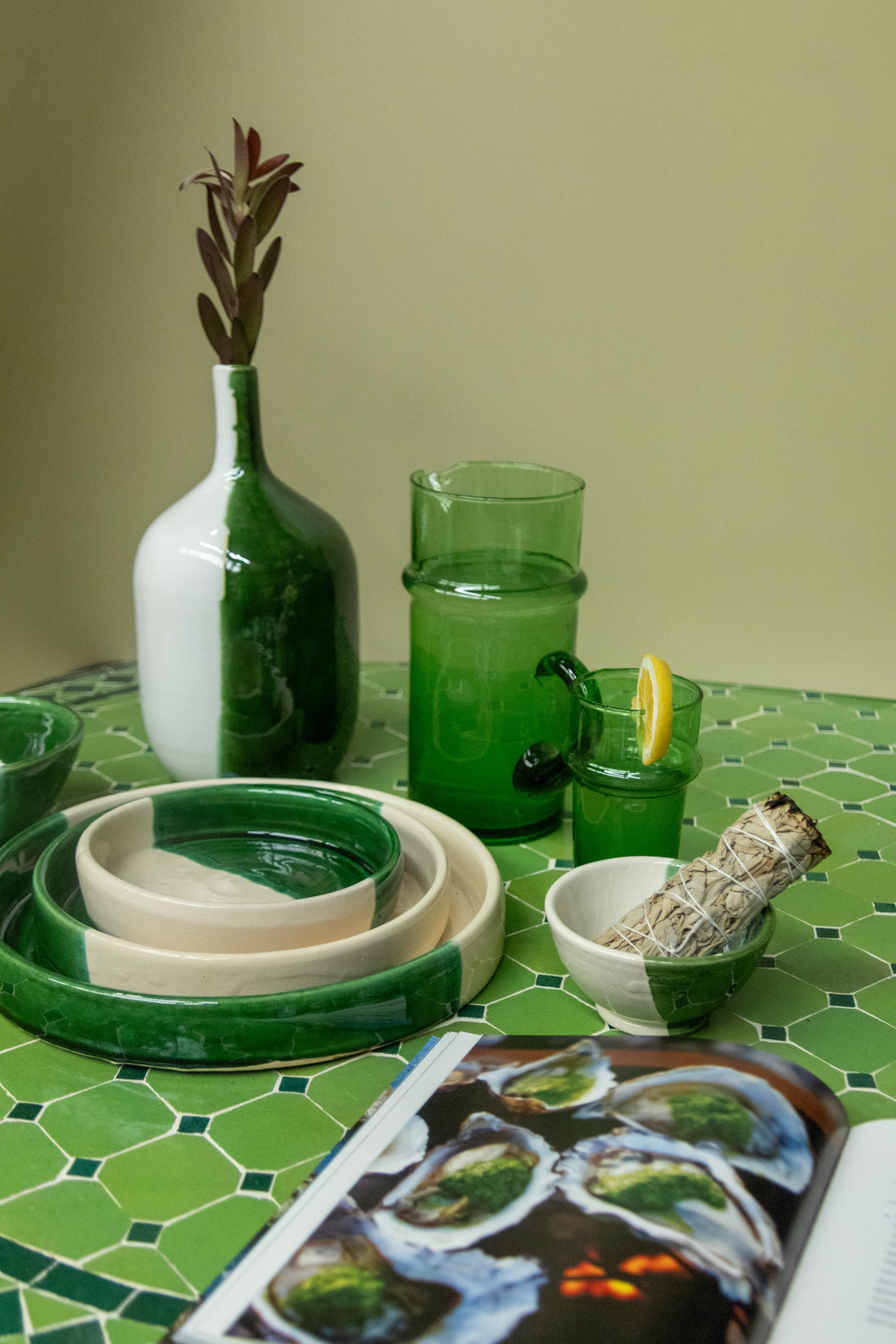
From Marrakech to the Marigny: The Design Dialogue Between Morocco and New Orleans
Share
From Marrakech to the Marigny: The Design Dialogue Between Morocco and New Orleans
By Voyage | New Orleans, LA
There are cities that pulse with spirit. That speak in rhythm and color. That never hide their age or their edges. Two such cities—on opposite sides of the Atlantic—continue to inspire our world at Voyage: Marrakech and New Orleans.
Separated by continents but united in soul, these two cultural meccas are mirrors in many ways. Both steeped in history, shaped by the convergence of cultures, and revered for their unapologetic celebration of life, Morocco and New Orleans share a design language that is rich, rhythmic, and deeply personal. From hand-carved wood to mosaic tile, ornate ironwork to sun-faded stucco, the similarities between these places transcend geography and reveal a shared design DNA that we return to again and again.
As curators of handmade, globally sourced home decor, we find endless inspiration in the ways Morocco and New Orleans embrace warmth, history, and imperfection. Here’s a closer look at how these two soulful places continue to shape the way we live, layer, and love our spaces.
1. A Love Affair With Pattern and Patina
In both Moroccan riads and Creole cottages, there’s an unspoken rule: the more layers, the better. These are spaces meant to be lived in and passed down. Not pristine, but personal.
Moroccan interiors are famous for their intricate zellige tilework—geometric, hand-cut, and often centuries old. Similarly, walk through the French Quarter or Bywater and you’ll find checkerboard porch tiles, patterned brick courtyards, and hand-laid mosaics, each telling a quiet story beneath your feet.
At Voyage, we’re drawn to these details. Our imported Moroccan fountains—available by appointment in our Bywater warehouse—echo the energy of a New Orleans courtyard. Each one combines function and ornament, sound and soul, much like the trickling garden fountains of the French Quarter.
Design Note: Whether in a tiled entryway or around a weathered fireplace, use patterned elements to create a sense of place—especially when mixing old and new.
2. Ornate Ironwork and Architectural Romance
New Orleans is draped in lace-like wrought iron: balcony railings, gates, lanterns, and fencing all bearing elaborate designs that feel part-Spanish, part-French, and wholly local. In Morocco, you’ll find similarly expressive ironwork—on window grilles, courtyard doors, and lanterns suspended in cool, tiled riads.
The romance of these flourishes lies in their function as art. Neither city treats utilitarian elements as mundane. In both places, even a simple window can be dressed in hand-forged beauty.
This ethos informs our sourcing at Voyage. We’re always looking for pieces that elevate the everyday—whether it’s an antique keyhole, a carved door panel, or a pair of hand-punched lanterns that cast celestial shadows at dusk.
Tip: Iron and carved wood age beautifully. Let patina be part of the palette.
3. The Power of the Courtyard
Perhaps the strongest design thread between Morocco and New Orleans is the central courtyard. Private, serene, and sun-soaked, these open-air oases offer a reprieve from the bustle of the street and serve as the soul of the home.
In Moroccan design, courtyards (or riad) often feature fountains, citrus trees, layered rugs, and low seating—a composition of stillness and sensory richness. In New Orleans, historic homes wrap around shaded courtyards laced with jasmine, climbing vines, and wrought iron tables set for lingering.
Our collection of hand-selected outdoor pieces—including carved stone tables, oversized urns, and terracotta planters—are designed for just such spaces. They bring old-world texture and elemental beauty to patios, balconies, and gardens alike.
Voyage Styling Tip: Mix and match Moroccan planters and vintage seating for a look that feels layered over time—not over-designed.
4. The Celebration of Craft
Craftsmanship is the heartbeat of both cultures. In Morocco, artisanship is passed from generation to generation: zellige tile-makers in Fez, weavers in the Atlas Mountains, glassblowers in Casablanca. In New Orleans, there’s a similar reverence for the handmade—from the iron forgers and woodworkers of old to today’s preservationists and artisans.
At Voyage, we honor this legacy by sourcing directly from Moroccan makers whose hands still shape every piece. And we see parallels with the craftsmanship found right here in the Crescent City, where even the oldest homes bear the marks of human touch—hand-carved mantels, beaded ceilings, and ornate plaster moldings.
Shop With Intention: Every Voyage piece has a human story. Invest in objects that carry tradition into the future.
5. Color That Speaks Louder Than Words
Walk through the medina of Marrakech or the Marigny of New Orleans, and you’ll see a shared confidence in color: saffron, cobalt, coral, ochre, sage. The sun-washed palette reflects both cities’ love of vibrancy and their climate-driven practicality.
These aren’t colors chosen to match—they’re chosen to move. To energize, soften, and embrace the natural wear of time.
We bring this same philosophy to our curated offerings—from handwoven textiles and vintage rugs to one-of-a-kind pottery glazed in palettes that mimic the spice markets of Morocco or the fading facades of Frenchmen Street.
Palette Inspiration: Use color in unexpected ways—inside a bookshelf, across a floor tile, or as a bold accent in an otherwise neutral space.
The Bridge Between Two Worlds
At Voyage, we don’t just collect home decor—we collect cultures. Morocco and New Orleans feel like twin flames in our design philosophy: both cities revere beauty, embrace imperfection, and find magic in the handmade.
We invite you to explore this cross-cultural kinship in our Bywater warehouse, where Moroccan tile meets Southern soul, and every object tells a story that spans continents.
To experience our curated collection firsthand, book an appointment by emailing hello@voyage-living.com or sending us a DM at @voyage.living. Let us help you bring home something that speaks to both the past and the present, and bridges your space to the world.
From Crescent City to Kasbah, design lives in the details.
And at Voyage, those details are what turn a house into a haven.
